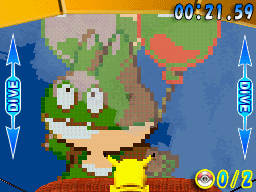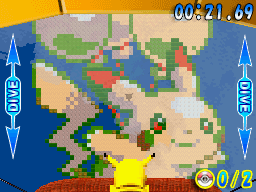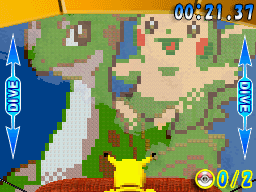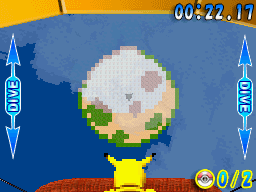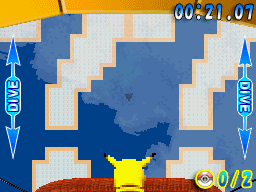Pokémon Dash
| Pokémon Dash |
|---|
|
Developer: Ambrella[1]
|
| To do: Prerelease stuff, when it was just a Pikachu demo. |
A racing game starring Pikachu where you drag the stylus and race other Pokémon. As a launch title for the DS, it doubles as a comprehensive tech demo covering all novelty features of the system... and unofficially, as an infomercial for replacement touch screens!
Contents
Unused Graphics
taikenban.ngc
Leftovers from a demo version, found in the Japanese version and translated in the US version.
Development Text
buildinfo.txt
There's a .txt file named buildinfo.txt that contains compile information, but it's blank in all regions.
Cup Order
| Gameplay order | Internal numbering | Title |
|---|---|---|
| 1 | 2 | Green Cup |
| 2 | 4 | White Cup |
| 3 | 1 | Blue Cup |
| 4 | 5 | Yellow Cup |
| 5 | 3 | Red Cup |
Unused Cup Courses
There is a total of 5 (24 if considered each "??" ID as a different) unused courses across versions. These courses can be played in any version with these Action Replay codes that modify the species ID of the first Pokémon slot from the first cup. All the Pokémon share the same ID as the core Generation III Pokémon games, but Deoxys forms ID start at 0xFC.
| Japan | USA | Europe | Korea |
|---|---|---|---|
| 120D4DB0 0000XXXX | 120D5814 0000XXXX | 120D5894 0000XXXX | 120DF398 0000XXXX |
Regional Differences
Logo
| Japan | International |
|---|---|
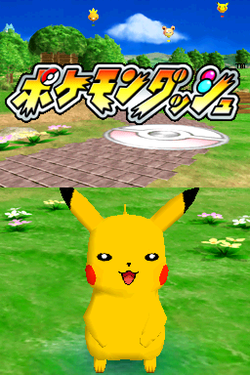 |
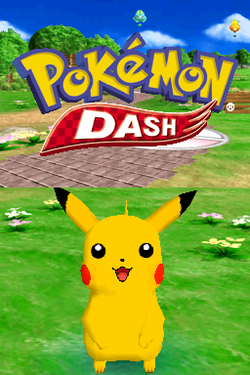 |
The logo in the Japanese version is completely different, with balloons and a Poké Ball.
Tutorial
| Japan | International |
|---|---|
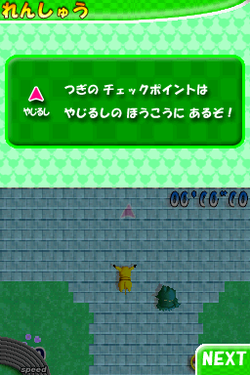 |
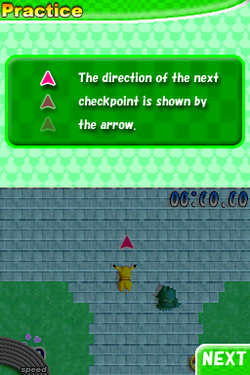 |
In the tutorial, one of the instructions in the Japanese version only has one arrow, but every other version has three.
Special Cup Top Screen
| Japan | International | Korea |
|---|---|---|
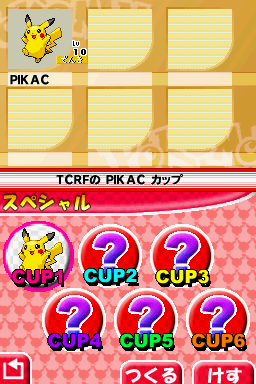
|
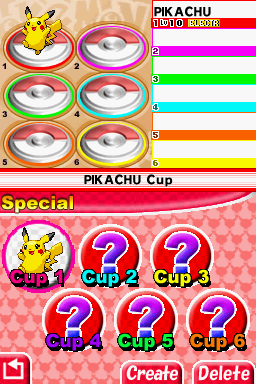
|
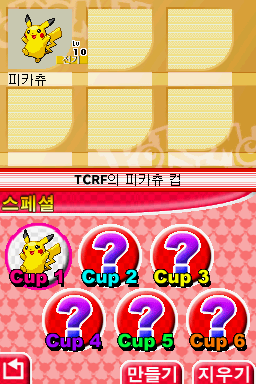
|
Each time you create a custom Special Cup using a Pokémon Sapphire/Ruby/FireRed/LeafGreen/Emerald cartridge inserted in the GBA slot of the Nintendo DS, a new course will be created based on the Pokémon you currently have in your party. The trainer's name is also stored in the cup's data, but it's only used in the Japanese and Korean version to display the cup's title. Likewise, the full nickname of each party slot is also stored, but it is displayed wrong in the Japanese version due to character limitation. Since no Generation III core Pokémon games were released in South Korea, the name of each species is automatically selected in the Korean version, even if the Pokémon is nicknamed. All versions also store the original trainer's name per Pokémon slot, but goes unused as well.
Generation III Game Compatibility
The Korean version will only allow Japanese Generation III cartridges to be used. All other versions allow Generation III cartridges from any region to be used.
References
- Games developed by Ambrella
- Pages missing publisher references
- Games published by The Pokémon Company
- Games published by Nintendo
- Nintendo DS games
- Games released in 2004
- Games released in December
- Games released on December 2
- Games with unused areas
- Games with hidden development-related text
- Games with unused graphics
- Games with regional differences
- To do
- Pokémon series
Cleanup > Pages missing publisher references
Cleanup > To do
Games > Games by content > Games with hidden development-related text
Games > Games by content > Games with regional differences
Games > Games by content > Games with unused areas
Games > Games by content > Games with unused graphics
Games > Games by developer > Games developed by Ambrella
Games > Games by platform > Nintendo DS games
Games > Games by publisher > Games published by Creatures
Games > Games by publisher > Games published by Game Freak
Games > Games by publisher > Games published by Nintendo
Games > Games by publisher > Games published by Nintendo > Games published by The Pokémon Company
Games > Games by release date > Games released in 2004
Games > Games by release date > Games released in December
Games > Games by release date > Games released in December > Games released on December 2
Games > Games by series > Pokémon series


